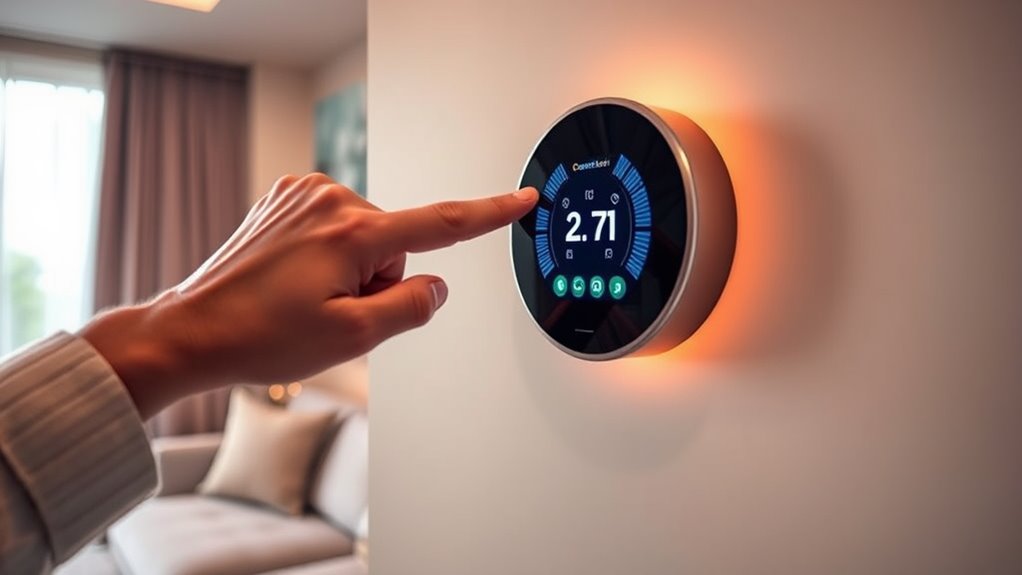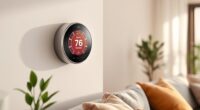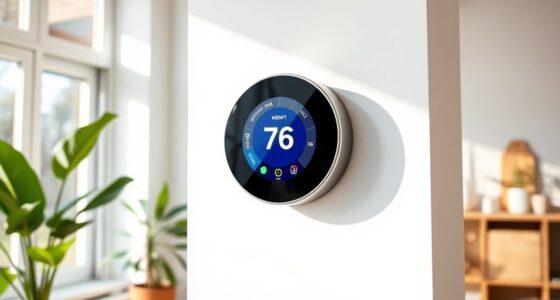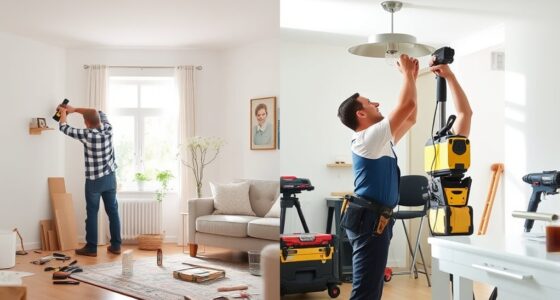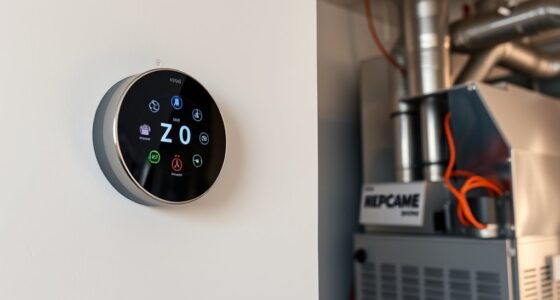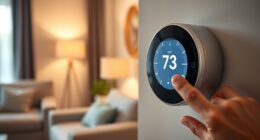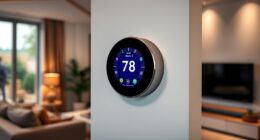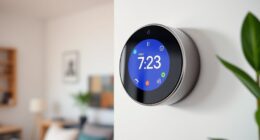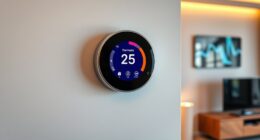To choose the right smart thermostat, start by confirming compatibility with your HVAC system, whether it’s forced air, heat pumps, or boilers. Look for features like learning algorithms, geofencing, and energy reports that help save money. Consider installation ease—some models are DIY-friendly, while others may need professional help. Make certain it works with your smart home ecosystem and voice assistants for seamless control. Keep these factors in mind to find the best fit for your home, and discover more tips ahead.
Key Takeaways
- Ensure compatibility with your existing HVAC system and check for necessary adapters or professional installation.
- Prioritize features like learning algorithms, geofencing, and energy reports to maximize energy savings.
- Choose a model that is easy to install yourself or hire a professional for proper setup and safety.
- Evaluate device reliability, responsiveness, and user reviews to ensure long-term performance.
- Confirm smart home ecosystem compatibility, such as Alexa or Google Assistant, for seamless integration.
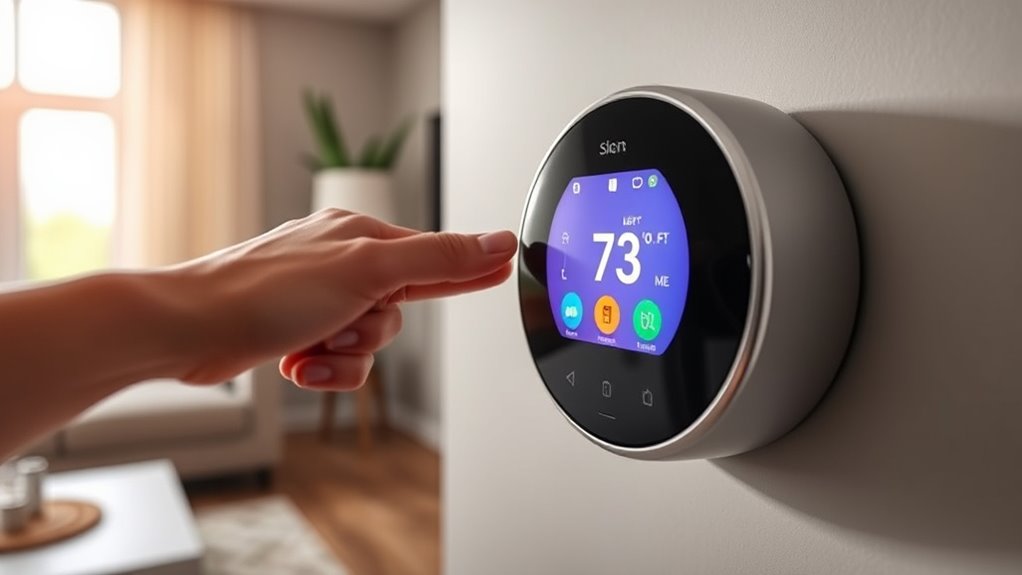
Choosing a smart thermostat can considerably enhance your home’s comfort and energy efficiency. When you’re shopping for one, it’s essential to consider how it will fit into your existing system and how much you could save on energy bills. The right model can make a noticeable difference in your utility costs, but only if it’s compatible with your current HVAC setup. Compatibility issues are common, so it’s important to do your homework before making a purchase.
First, check your home’s heating and cooling system to determine what type of thermostat it supports. Some smart thermostats are designed specifically for certain systems, like forced air, heat pumps, or boilers. If you buy a model incompatible with your system, you might face installation problems or have to spend extra on adapters or professional help. Take the time to read your HVAC system’s specifications and consult manufacturer guidelines to guarantee compatibility. Many smart thermostats list compatible systems on their product pages, which can help narrow your options.
Once you’ve confirmed compatibility, focus on how the thermostat can help you achieve energy savings. Look for features like learning algorithms that adapt to your schedule, geofencing that detects when you’re home or away, and detailed energy reports. These tools can help you optimize your heating and cooling patterns, reducing unnecessary energy consumption. Additionally, consider thermostats with remote control capabilities via smartphone apps, so you can adjust settings even when you’re not at home. This flexibility guarantees you’re not wasting energy when no one is around or during unoccupied hours.
Another key factor is ease of installation. If you’re comfortable with basic wiring, you might prefer models that offer DIY installation instructions. However, if your system has complex wiring or you’re unsure, hiring a professional can ensure everything is set up correctly and safely. Proper installation is vital to avoid compatibility issues and to guarantee your thermostat operates efficiently.
Furthermore, understanding the performance metrics of a thermostat, such as responsiveness and reliability, can influence your satisfaction and the device’s long-term functionality. Finally, think about the ecosystem you want to integrate with. Many smart thermostats work seamlessly with voice assistants like Amazon Alexa, Google Assistant, or Apple HomeKit. Compatibility with your preferred smart home ecosystem can enhance convenience and allow you to create routines that automate your climate control. Just make sure the thermostat you choose is compatible with your existing devices and network.
Frequently Asked Questions
Can I Install a Smart Thermostat Myself or Need a Professional?
You can definitely do a DIY installation of a smart thermostat if you’re comfortable with basic wiring and electrical work. Many models come with step-by-step instructions, making it manageable for handy homeowners. However, if you’re unsure about wiring or face complex system configurations, it’s best to seek professional assistance. A professional ensures safe installation, proper setup, and peak functioning of your smart thermostat, giving you peace of mind.
Will a Smart Thermostat Work With My Existing HVAC System?
Yes, a smart thermostat can work with your existing HVAC system, but you’ll need to verify its HVAC compatibility first. Make sure it matches your wiring requirements, as some systems may need additional wiring or adapters. Before installation, confirm that your current wiring setup supports the thermostat’s features. If you’re unsure, consulting a professional can help ensure proper compatibility and seamless integration with your HVAC system.
How Secure Is the Data Collected by Smart Thermostats?
Like the Declaration of Independence, your data privacy with smart thermostats matters. While manufacturers implement security measures, hacking risks still exist, so your data isn’t entirely foolproof. You should regularly update firmware, use strong passwords, and enable two-factor authentication. These steps help protect your data collected by smart thermostats, ensuring your personal information stays secure while you enjoy the convenience of smart home technology.
Do Smart Thermostats Require a Stable Wi-Fi Connection?
Yes, smart thermostats do require a stable Wi-Fi connection. You need reliable Wi-Fi stability and connection reliability to control your thermostat remotely, access updates, and ensure proper functioning. Without a steady internet connection, your thermostat might not respond promptly or update settings correctly. Make sure your Wi-Fi signal is strong and consistent in the area where your thermostat is installed to avoid disruptions and keep everything running smoothly.
Can I Control My Smart Thermostat Remotely From My Phone?
You can control your smart thermostat remotely from your phone, opening a world of convenience. With remote access and mobile control, you can adjust the temperature from anywhere, whether you’re at work or on vacation. It’s like having your home’s climate command center in your pocket, ensuring your space is always just right. So, yes, your smart thermostat makes managing your comfort effortless, no matter where life takes you.
Conclusion
Choosing the right smart thermostat is like finding the perfect key to release your home’s comfort and efficiency. When you consider your needs, compatibility, and features, you’re crafting a personalized climate control system that adapts seamlessly to your life. Trust your instincts, do your research, and select a device that fits like a glove. With the right thermostat, you’re steering your home’s comfort with confidence, turning your living space into a haven of warmth and savings.
